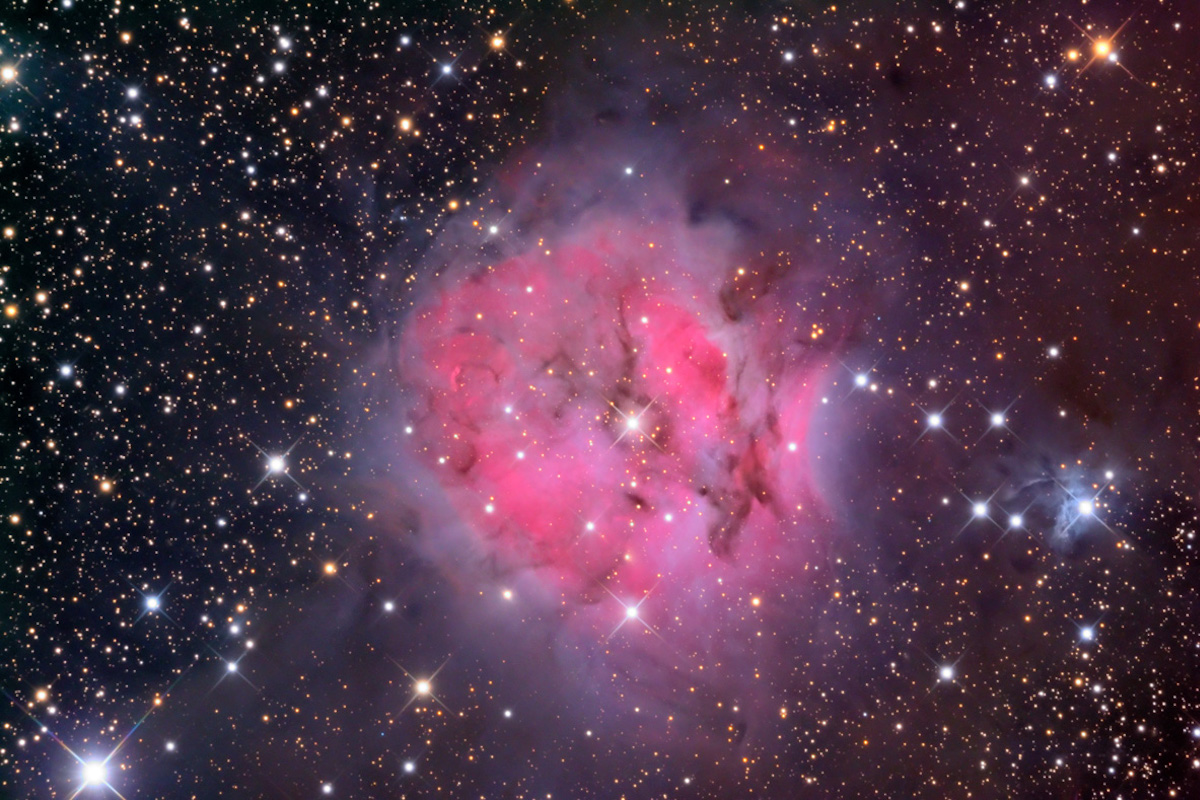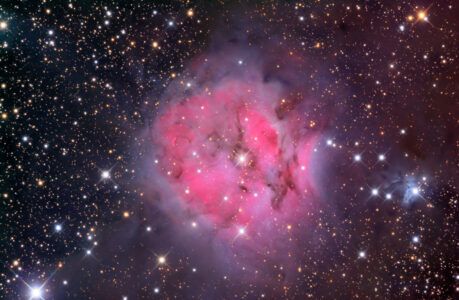Cocoon Nebula, officially known as IC 5146, is a fascinating object located in the constellation of Cygnus. This celestial spectacle is an intricate network of gas and dust clouds that stretch over 12 light-years across. Its name derives from its appearance, which resembles a silken cocoon enveloping a young star.
The nebula is classified as an emission and reflection nebula, meaning it is illuminated by a cluster of young stars that emit high-energy radiation. The radiation excites the surrounding gas and dust, causing it to glow in a mesmerizing array of colors, from soft pinks and blues to fiery oranges and yellows.
At the center of the Cocoon Nebula lies a young and massive star, designated as BD +46°3474. This star is estimated to be around 4,000 times brighter than the sun and has a surface temperature of around 30,000 degrees Celsius. Its intense radiation and stellar winds have carved out a cavity in the surrounding gas and dust clouds, creating a distinctive shape that resembles a tadpole.
One of the most intriguing aspects of the Cocoon Nebula is the presence of dark lanes and filaments that crisscross its bright, glowing regions. These dark features are thought to be dense clouds of gas and dust that block the light emitted by the stars behind them. They also provide clues about the early stages of star formation and the processes that shape the structure of the universe.
The Cocoon Nebula is located approximately 4,000 light-years away from Earth, making it a challenging object to observe with the naked eye. However, it is a popular target among amateur and professional astronomers alike, who use advanced telescopes and imaging techniques to capture its breathtaking beauty.
In recent years, the Cocoon Nebula has also become a subject of scientific research, with astronomers studying its properties and composition to better understand the mechanisms of star formation and the evolution of galaxies.
In conclusion, the Cocoon Nebula is a stunning example of the wonders that exist in our universe. Its intricate structure, vibrant colors, and fascinating features make it a favorite among astronomers and stargazers alike. Whether you observe it through a telescope or simply marvel at its beauty from afar, this celestial phenomenon is sure to leave a lasting impression on anyone who encounters it.
Where can I find the Cocoon Nebula (IC 5146)
The Cocoon Nebula (IC 5146) is located in the constellation of Cygnus, which is visible from the Northern Hemisphere during the summer months. Its exact coordinates are Right Ascension 21h 53m 24s and Declination +47° 16′ 00″. However, due to its distance from Earth (approximately 4,000 light-years), it can be challenging to observe with the naked eye. It is best viewed with a telescope or binoculars under dark skies with minimal light pollution.
BD +46°3474
BD +46°3474 is a massive young star located at the center of the Cocoon Nebula (IC 5146). It has a surface temperature of around 30,000 degrees Celsius and is estimated to be approximately 4,000 times brighter than the sun. The intense radiation and stellar winds emitted by this star have carved out a cavity in the surrounding gas and dust clouds, creating the unique tadpole shape that is a defining feature of the Cocoon Nebula. BD +46°3474 is a subject of interest for astronomers, who study it to better understand the processes of star formation and the evolution of galaxies.

